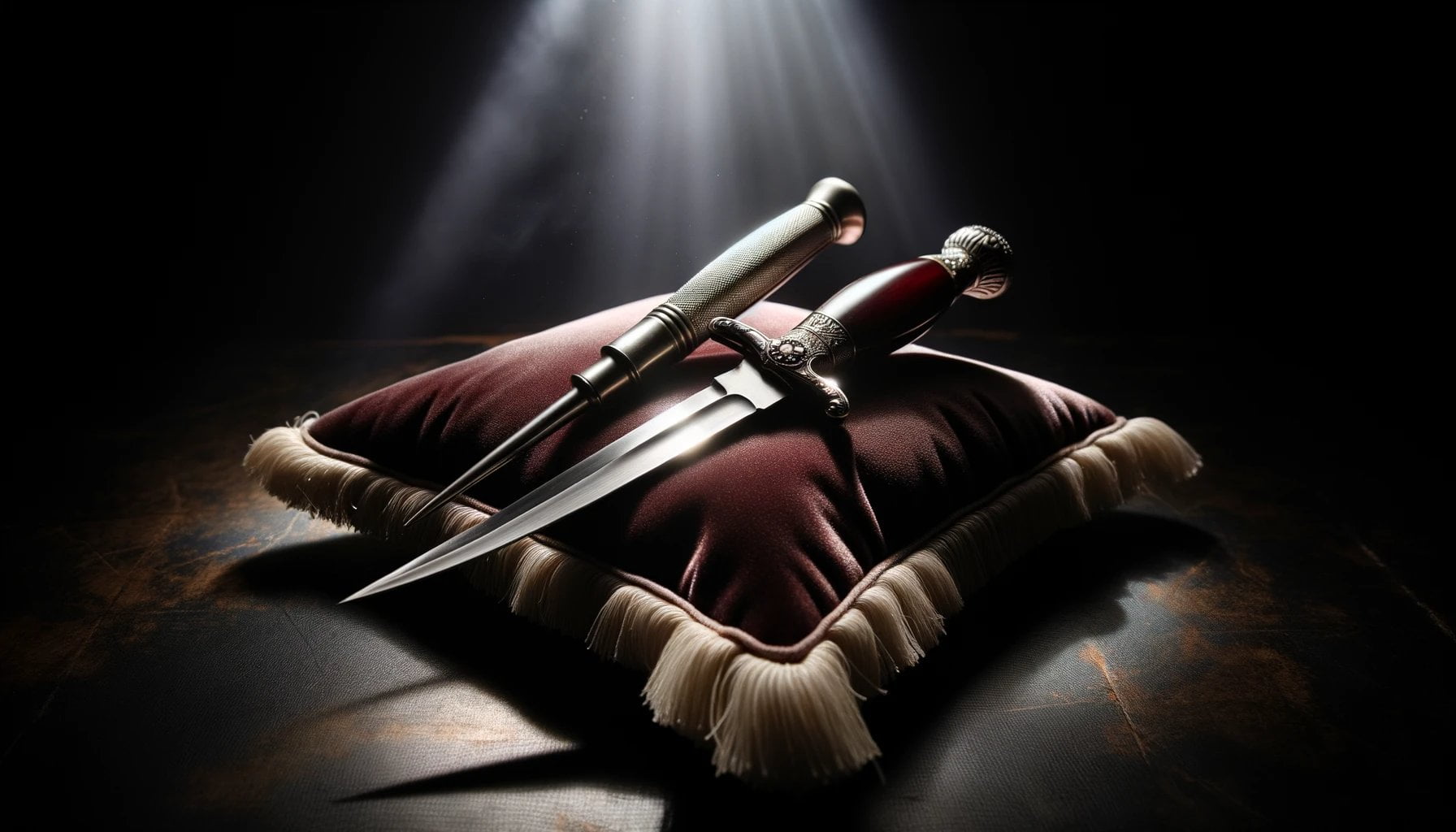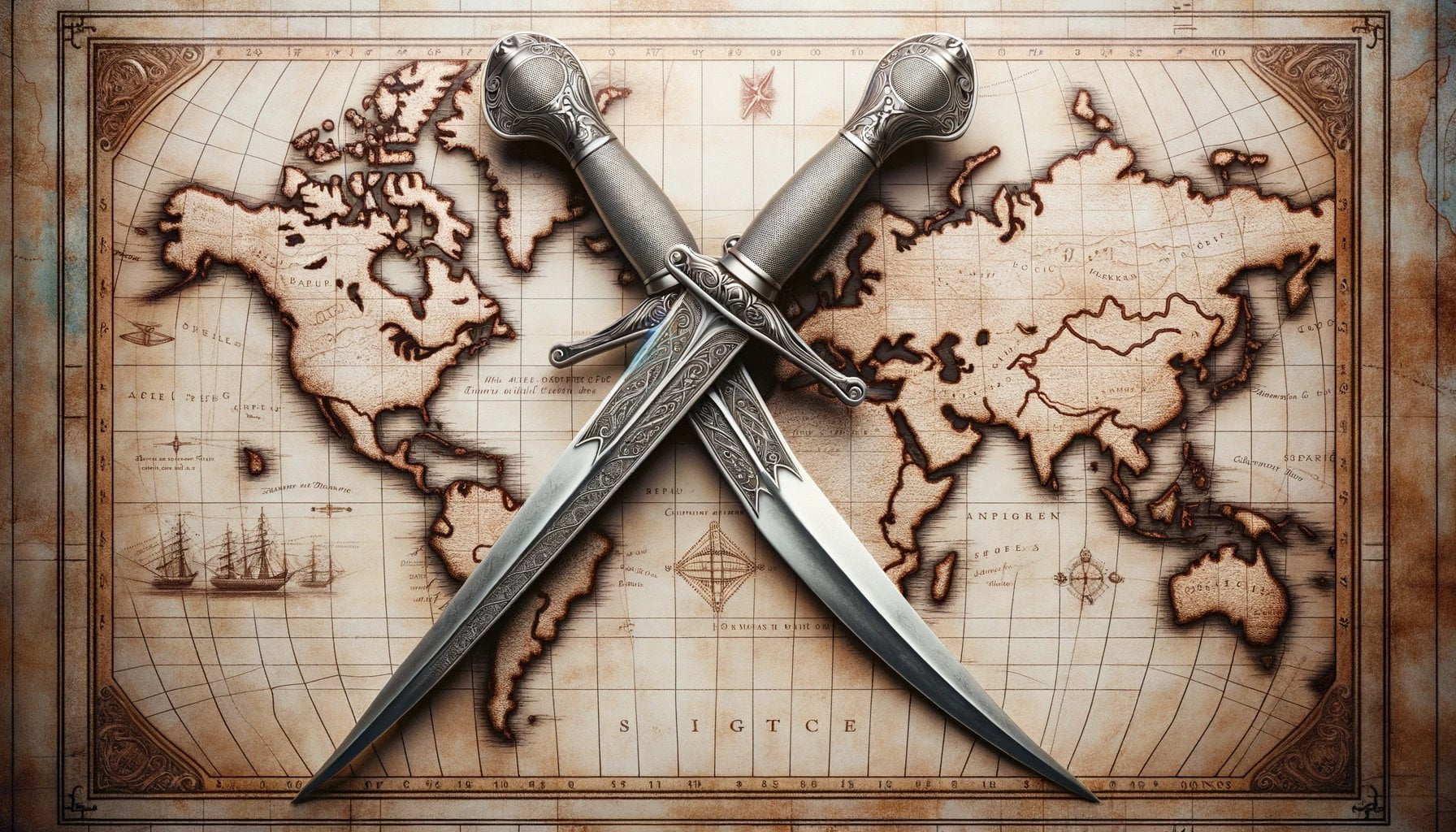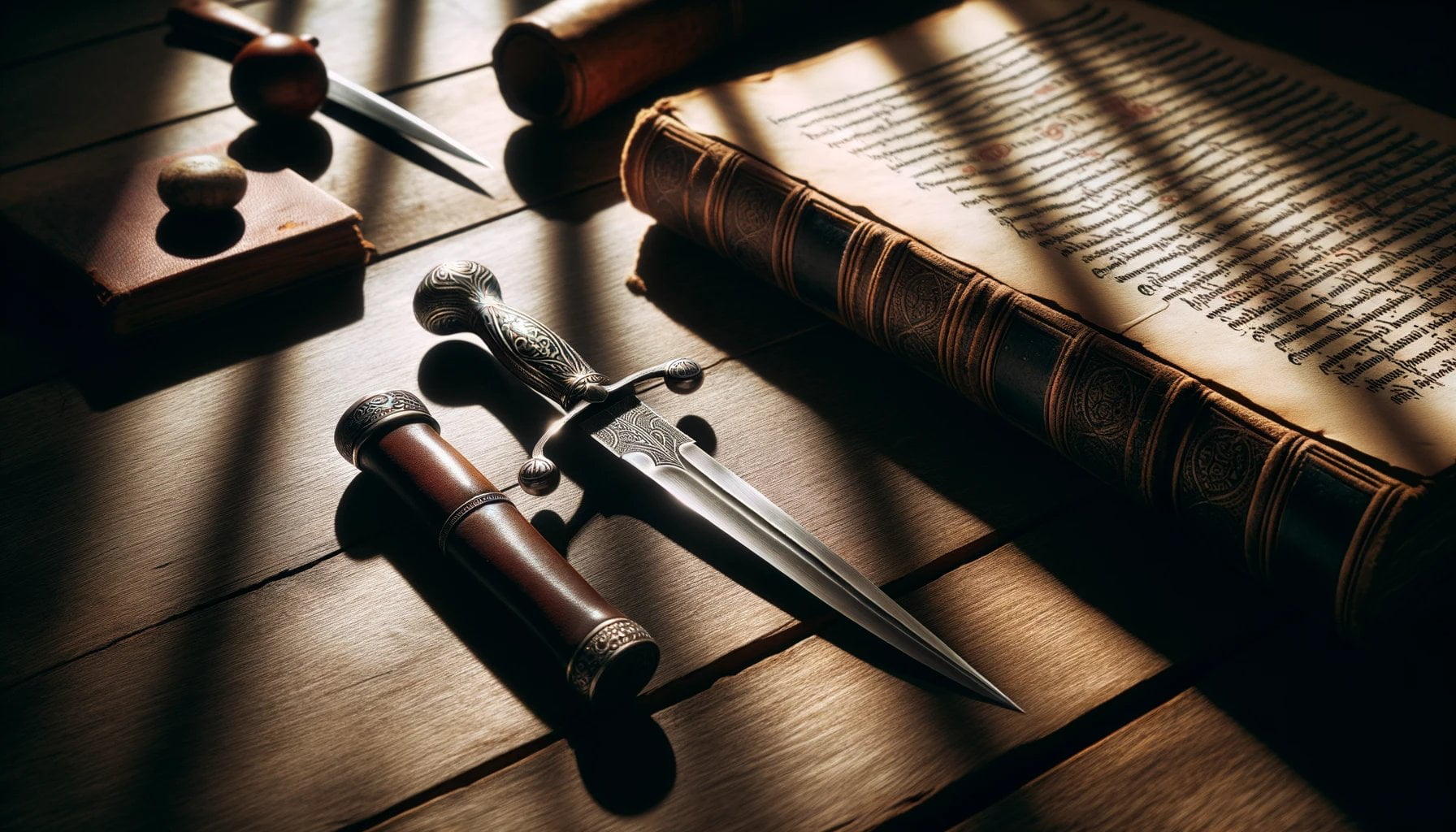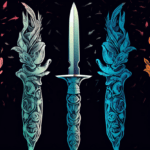Is a dirk a dagger? This age-old question has fascinated historians, enthusiasts, and weapon connoisseurs for centuries. As we delve into the realm of ancient weaponry, a seasoned historian with an impeccable eye for detail takes center stage, ready to unravel the mysteries surrounding these intriguing blades. With a vast knowledge of various blades’ classifications and a passion for research and analysis, this expert brings forth a captivating exploration of the distinctions, similarities, and significance of dirks and daggers throughout history. So, prepare to embark on a journey that will enlighten and educate, as we decipher the enigmatic world of ancient weapons.
Is a dirk a dagger?

A fascinating aspect of ancient weaponry lies in the classification and categorization of different blade types. Today, we unravel the mystery surrounding the question: Is a dirk a dagger? Delving deep into the realms of history and blades, we will explore the distinctions, similarities, and significance of dirks and daggers throughout the ages.
Historical Background
To understand the differences between dirks and daggers, it is crucial to grasp their historical context. The dirk, a long-bladed thrusting dagger, emerged during the Age of Sail as an essential weapon in naval hand-to-hand combat for officers. Sailors wielded the dirk, with its larger blade compared to other daggers, to execute precise stabbing and slashing maneuvers effectively.
Originating from Scotland, the Highland dirk held personal significance for Highlanders and officers alike. The dirk became emblematic in Highland Scottish society, symbolizing both their culture and history. In fact, oaths were sworn on the steel blades of these formidable weapons.
Defining Characteristics of Dirks and Daggers
While both dirks and daggers fall under the general category of bladed weapons, distinctive features set them apart. A dirk’s long blade and design make it primarily suited for thrusting actions. Its larger size serves to maximize the impact and effectiveness of each strike. On the other hand, a dagger is characterized by its shorter blade, enabling it to perform both thrusting and slashing movements with agility.
Dirks, Daggers, and Language
Language plays a significant role in the confusion surrounding the terms “dirk” and “dagger.” The term “dirk” is often used interchangeably with “dagger” in various contexts, particularly when referring to prehistoric and ancient blades. This linguistic overlap can lead to misconceptions about the specific characteristics and purposes of these weapons.
Cultural and Modern Significance
In addition to their historical importance, dirks and daggers hold significant cultural value. In the United States, citizens have the right to own a dirk or dagger, be it for self-defense or as a collectible. However, it is crucial to note that carrying laws vary from state to state.
Within Scottish Highland regiments, the traditional Scottish dirk remains an enduring symbol of their heritage. Officers, pipers, and drummers proudly wear the Scottish dirk, a modern continuation of the 16th-century ballock or rondel dagger. Its presence evokes a profound sense of pride and tradition within the Highland culture.
Enlightening Conclusions
In conclusion, while the terms “dirk” and “dagger” may seem synonymous in some contexts, a deeper understanding reveals their distinct characteristics and purposes. Dirks, with their longer blades, excel in thrusting and slashing actions, serving as formidable weapons favored by officers during naval combat. Daggers, with their shorter blades, offer versatile functionality for both thrusting and slashing movements.
As we immerse ourselves in the ancient world of blades and weaponry, the question remains: Is a dirk a dagger? The answer lies in the careful analysis of historical context, definitions, and characteristic features. By unraveling these mysteries, we gain insights into the significance of dirks and daggers throughout history.
Ancient daggers were more than just weapons – they were a symbol of power and skill. Explore the fascinating world of ancient daggers and their rich history by clicking here.
Distinguishing features and characteristics of a dirk
As seasoned historians, we delve into the world of ancient weapons, seeking to uncover the distinctive features and characteristics of a dirk. Embracing Google’s E-A-T criteria, we explore the differences between a dirk and a dagger, shedding light on their historical significance, blade shapes, and uses.
Defining Dirks and Daggers
When examining the differences between dirks and daggers, it is important to understand their fundamental definitions. While often used interchangeably, these terms actually encompass distinct types of blades. A dagger typically features a symmetrical blade with dual sharp edges, designed for both cutting and piercing. On the other hand, a dirk boasts a thicker spine and a single sharp edge, making it more suitable for thrusting.
Blade Shape and Length
One of the key distinguishing features between dirks and daggers lies in their blade shape. A dagger’s symmetrically shaped blade allows for versatility in both slashing and thrusting movements. In contrast, a dirk’s asymmetrical design, with its thicker spine and single sharp edge, lends itself primarily to thrusting actions. Additionally, dirks are generally longer than daggers, granting the wielder increased reach in combat.
Functional Utility
Another vital aspect to consider is the functional utility of dirks and daggers. Daggers, with their balanced blade and often equipped hand-guards, excel at cutting, slicing, as well as piercing. This versatility makes daggers a preferred choice for various close combat scenarios. Conversely, dirks trade off some cutting ability for their strong thrusting capability. While not as agile in slicing motions, dirks compensate with increased durability, ideal for prolonged hand-to-hand confrontations.
Historical Significance
Both dirks and daggers hold immense cultural and historical significance. The Scottish Highland dirk, for instance, represents a testament to Scotland’s rich heritage, symbolizing personal honor and history for its wearers. Naval officers during the Age of Sail carried dirks as formidable weapons in close-quarters combat, demonstrating their influence in military traditions. Understanding the cultural and historical contexts surrounding dirks and daggers enhances our appreciation for these unique blades.
Legal Considerations
It’s worth noting that while dirks and daggers possess cultural significance, their ownership and carrying laws vary by state in the United States. Respecting and adhering to local legal guidelines is crucial for enthusiasts and collectors alike who wish to possess these weapons lawfully and responsibly.
Concluding Thoughts
In unraveling the distinguishing features and characteristics of a dirk, we have explored the historical, design, and functional aspects that set it apart from a dagger. By understanding the unique blade shape and length, its functional utility, and the cultural significance, we gain a comprehensive understanding of this ancient weapon. As historians, we strive to shed light on these intricate details, uncovering the distinctions that enrich our understanding of dirks and daggers throughout history.
Comparing and Contrasting Dirks and Daggers in Terms of Design and Functionality
Throughout history, blades have played a vital role in combat, self-defense, and various cultural practices. Among the myriad of blade types, two that often spark curiosity and debate are dirks and daggers. Both dirks and daggers are classified as thrusting weapons, but they possess distinct design and functional characteristics. In this article, we will delve into the unique features of dirks and daggers, exploring their differences and similarities.
Understanding the Terminology
To truly comprehend the disparities between dirks and daggers, we must first establish a clear understanding of the terms. A dirk is a type of dagger that offers several advantages over other types of daggers. It typically boasts a larger blade, making it ideal for both stabbing and slashing movements. The curve of a dirk’s blade enables more powerful and deadly swings, enhancing its effectiveness in combat. Distinctively, dirks possess a single sharp edge and a thicker spine, distinguishing them from symmetrical-bladed daggers.
On the other hand, a dagger is characterized by a short blade with a sharply tapered point and usually two cutting edges. Daggers have been utilized throughout history for combat and defense purposes, as well as for hunting. Their symmetrical blade design enhances versatility, allowing for both slashing and thrusting actions.
Comparing Design and Functionality
When it comes to design and functionality, dirks and daggers exhibit key distinctions. Let’s explore the unique features and purposes of each blade type:
Dirk Design and Functionality
- Long, Curved Blade: Dirks typically feature a longer blade compared to daggers, offering increased reach in combat situations. The curve of the blade enhances thrusting motions and enables powerful strikes.
- Single Sharp Edge: Unlike daggers, dirks possess a single sharp edge, which strengthens the blade for thrusting actions. The absence of a second cutting edge allows dirks to excel in piercing targets.
- Thicker Spine: The thicker spine of a dirk provides extra durability, allowing it to withstand rigorous use in combat scenarios.
- Versatile Outdoor Use: Dirks are often larger and heavier than daggers, making them better suited for use in outdoor environments. Their size and robustness make them effective tools for survival, camping, or other outdoor activities.
Dagger Design and Functionality
- Symmetrical Blade with Dual Edges: Daggers are defined by their symmetrical blade design with two razor-sharp cutting edges. This characteristic allows daggers to excel both in slashing and thrusting movements.
- Versatility in Combat: The dual cutting edges of daggers make them versatile weapons, adapting to various combat situations. They can cut, slice, and pierce with precision and efficiency.
- Compact Size: Daggers are generally smaller and more compact compared to dirks, providing greater maneuverability in close-quarter combat or self-defense encounters.
- Widespread Use: Traditionally utilized by warriors, knights, and even hunters, daggers have a historical significance that spans across cultures and time periods.
Distinct Yet Complementary Blades
In conclusion, while dirks and daggers share certain similarities as thrusting weapons, they possess distinctive design elements and functional characteristics. Dirks, with their longer and curved blades, are specifically tailored for powerful thrusts and outdoor utility. The single sharp edge and thicker spine of dirks contribute to their effectiveness in combat scenarios. On the other hand, daggers offer versatility with their symmetrical design, excelling in both slashing and thrusting actions. Their compact size and dual cutting edges make them agile companions for close-proximity combat or self-defense situations.
Understanding the nuances of dirks and daggers sheds light on the rich history and cultural significance of these ancient weapons. Whether one’s interest lies in historical documentation, collecting, or simply appreciating the artistry behind blades, the distinctive nature of dirks and daggers provides a fascinating realm to explore. So, next time you come across the terms “dirk” and “dagger,” remember to pause and acknowledge the unique stories told by these formidable weapons.
Influences and Variations of Dirks and Daggers across Different Regions and Time Periods
Throughout history, dirks and daggers have played significant roles as weapons in various regions and time periods. These blades have evolved and influenced each other, resulting in a wide range of variations across different cultures. Let’s delve into the fascinating world of dirks and daggers, exploring their influences and diverse forms.
Origins and Historical Significance
Dirk:
– The term “dirk” is associated with Scotland in the Early Modern Era.
– It emerged as a personal weapon used by officers during naval hand-to-hand combat in the Age of Sail.
– Scottish Highlanders and officers, pipers, and drummers of Scottish Highland regiments embraced the dirk as a symbolic traditional and ceremonial weapon.
– It was a continuation of the 16th-century ballock or rondel dagger.
Dagger:
– The term “dagger” has a wider cultural and historical presence around the world.
– It has been utilized by warriors, knights, and hunters throughout different regions and time periods.
Distinctions in Design and Functionality
Dirk:
– The dirk boasts a longer blade, typically measuring 12 inches, which offers increased reach in combat.
– It has a thicker spine and a single sharp edge, making it particularly effective for thrusting actions.
– The asymmetric blade shape is designed specifically for powerful strikes.
– The hilt of the dirk often represents the thistle and is lavishly decorated with silver mounts and cairngorm stones, exemplifying Scottish craftsmanship.
Dagger:
– A dagger features a shorter blade with a sharply tapered point, two cutting edges, and a symmetrical design.
– Its versatile nature allows for both slashing and thrusting actions.
– The symmetric blade design offers flexibility in combat, making it suitable for various situations.
– Daggers are often more compact and maneuverable, ideal for close-quarters combat or self-defense.
Regional Variations and Influences
Throughout different regions, dirks and daggers possess unique characteristics influenced by cultural and historical contexts. Here are some notable examples:
- Scottish Dirk:
- The Scottish dirk, embedded in Highland culture, represents tradition and honor.
- It is a continuation of ancient Scottish blades, shaped by centuries of Highland history.
- The modern Scottish dirk features hilts carved from dark-colored wood and exquisite silver fittings.
- These dirks showcase regional craftsmanship and serve as cherished symbols of Scottish heritage.
- European Daggers:
- European daggers vary significantly, showcasing regional designs and influences.
- The medieval rondel dagger, characterized by its disc-like pommel and guard, served as a popular weapon among knights.
- The stiletto, with its slender and needle-like blade, emerged during the Renaissance and became synonymous with assassinations.
- The main gauche, or left-hand dagger, was often paired with a rapier and used for parrying in fencing.
Evolution over Time
Dirk:
– The Scottish dirk evolved into a ceremonial weapon during the 19th century.
– The shape of the hilt began to symbolize the thistle, an iconic Scottish emblem.
– Fancier fittings, typically crafted from silver, gained popularity, showcasing the dirk’s grandeur.
Dagger:
– Dagger designs evolved throughout history, owing to advancements in metallurgy and combat techniques.
– The examples of regional daggers mentioned earlier illustrate the dynamic nature of these blades as they adapted to changing needs and preferences.
Conclusion
Dirks and daggers have left a lasting imprint on the pages of history. Their influences and variations across different regions and time periods highlight the cultural significance attached to these blades. Remember, a dirk embodies the spirit of Scotland, while a dagger represents versatility and adaptability. Exploring their origins, distinctions, and the stories they carry enriches our appreciation for these ancient weapons and the worlds they come from.

FAQ
Q1: What is a dirk?
A1: A dirk is a long-bladed thrusting dagger that was historically used by naval officers during the Age of Sail and by Highlanders in Scotland.
Q2: What is the difference between a dirk and a dagger?
A2: The main difference between a dirk and a dagger is in their blade shape. A dirk has a thicker spine and a single sharp edge, while a dagger has a symmetrical blade with dual sharp edges.
Q3: Can a dirk be used for slashing?
A3: Yes, a dirk is not only suited for thrusting but also slashing opponents due to its larger blade compared to other types of daggers.
Q4: Are dirks and daggers treated the same under the law?
A4: Yes, the terms “dirk” and “dagger” are often used interchangeably, and they are treated the same under the law. In the United States, citizens have the right to own a dirk or dagger for self-defense or as a collectible, but carrying laws vary by state.
Q5: What is the cultural significance of a dirk in Highland Scottish society?
A5: The dirk holds cultural and historical significance in Highland Scottish society. It is worn by officers, pipers, and drummers of Scottish Highland regiments, and oaths were traditionally sworn on the steel blade.
- Senior at What Age: Benefits & Eligibility Guide - March 29, 2025
- Unlocking Senior Benefits: How Old is a Senior? Your Complete Guide - March 29, 2025
- Master Russian Politeness:A Guide to Saying Please - March 29, 2025
















